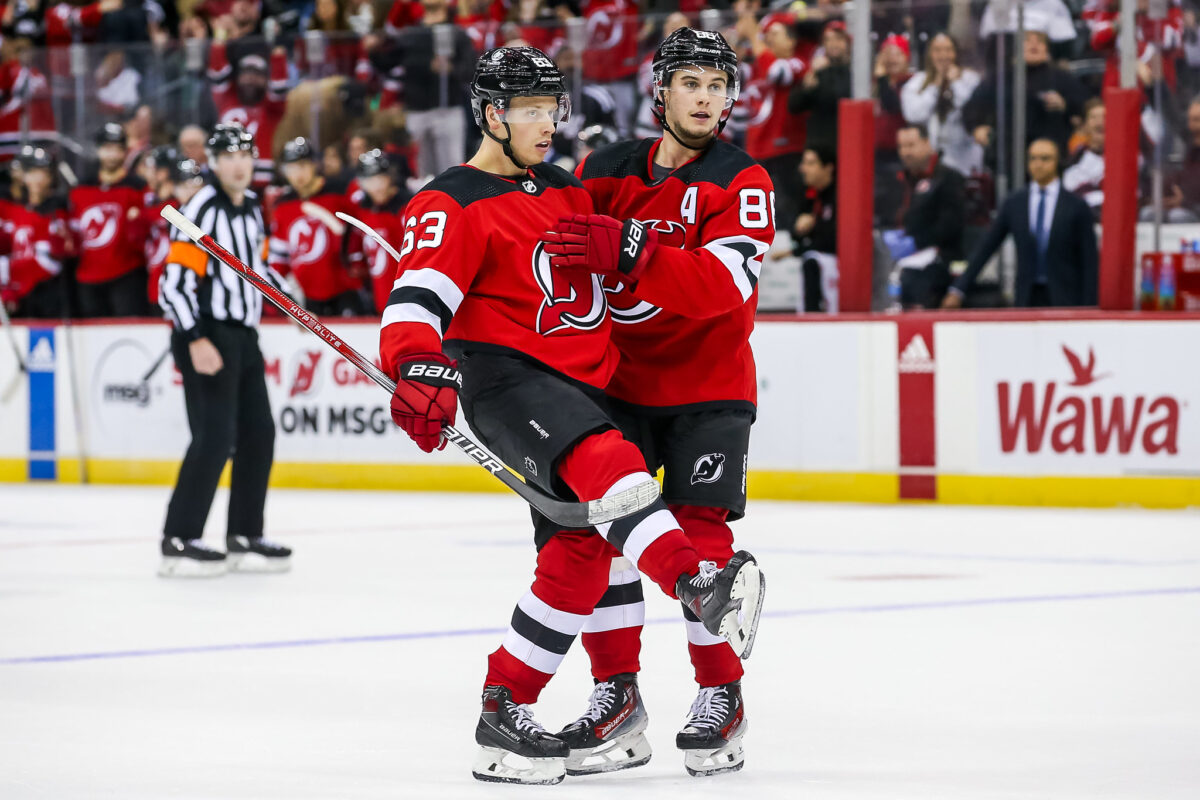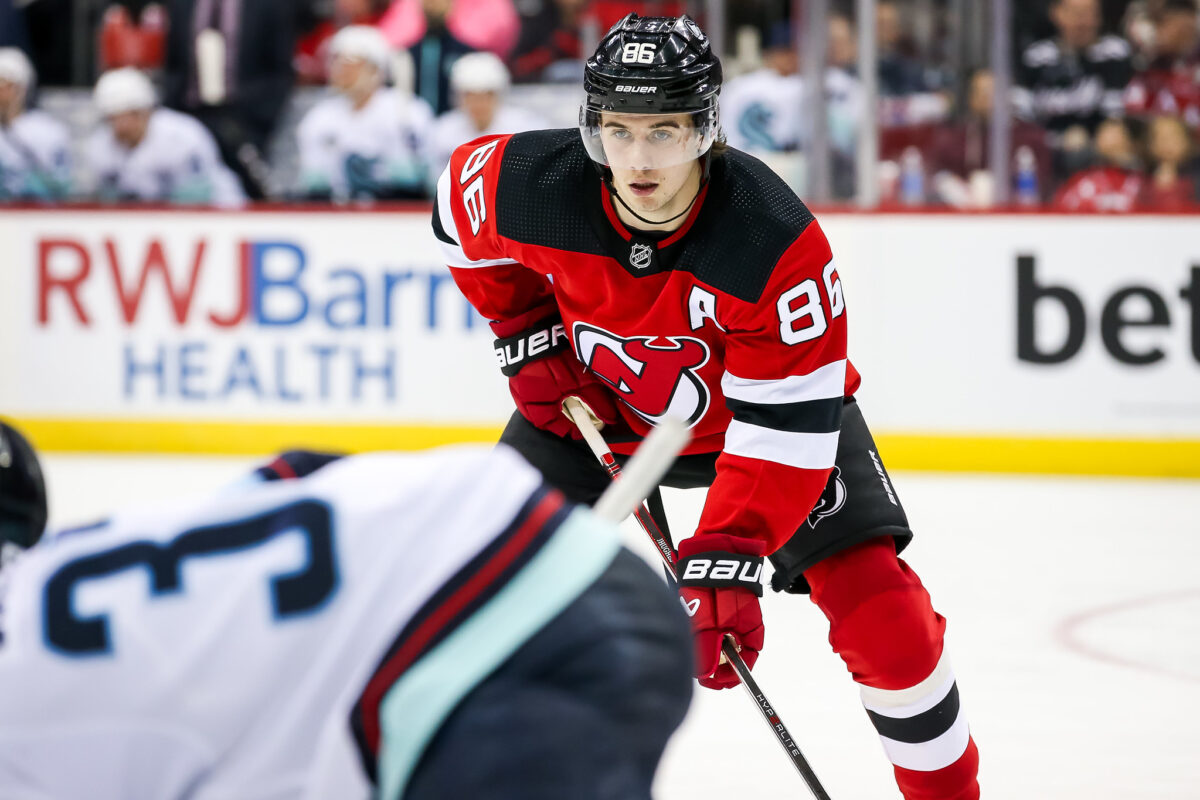More than most, the New Jersey Devils’ game Saturday night against the Washington Capitals was a true microcosm of their season. Flashes of brilliance, success when they forecheck, inability to score off the rush, and excellent penalty killing. Unfortunately for New Jersey, the brilliance exhibited in the first five minutes of the game and the opening 45 seconds of the second period was overshadowed by the inability to get clean exits and maintain coverage structures. The team has gone from a dominating overseas trip to a 3-3 record in North America, plagued by inconsistency and lacking scoring from their stars.
The positive takeaway for New Jersey must be that they have the talent and have demonstrated a path to win different types of games, which was lacking in the brutal 2023-24 season. What has to be frustrating is the lack of results they have gotten from Jack Hughes and Jesper Bratt. Yes, the pair have combined for 12 points this season in eight games, but the lack of impact on games has been noticeable, and the team can only survive on goals from secondary scorers for so long.
Related: Shakeup to Devils’ Bottom 4 Would Help Nemec
Paul Cotter, Stefan Noesen, and Erik Haula individually have more even-strength goals than Hughes and Bratt combined. Historically, both players have scored the majority of their goals at even-strength. Of his 115 career goals, Hughes scored 86 times at even-strength, while for Bratt, it was 102 of his 130. Only six of the pair’s 12 points have come at even strength this season. Bratt has yet to score an even-strength goal through eight games. Here is a look at what has gone wrong and whether it is time to hit the panic button or continue patience.
Shots, Shots, Shots
Hughes is known for being much more of a volume shooter than Bratt, who is a more efficient shooter, choosing to limit his opportunities to high-danger areas instead. Both methods have proven effective as the pair have been the most consistent scorers for New Jersey as the team ascended into contender status. Over the last three seasons, they have combined for 181 goals in 429 games. Hughes alone has scored 96 goals in 189 games. The difference this season isn’t in the number of shots or opportunities; it lies in the rate of conversion.
For his career, Hughes shoots just below 11%. Throughout the last three seasons, as he has emerged as a superstar, his shooting percentage has risen to 12.4%. Last season, he finished at 9.9%, slipping below 10 later in the season, largely due to the impact of the shoulder injury he had surgically repaired in April. Through eight games last season, Hughes had five goals, 18 points, 31 shots on goal, and was shooting over 16%. This season, he has one goal, five points, 22 shots on goal, and is shooting 4.5%.

Bratt has had a similarly frustrating start. He shoots 12.1% over his eight seasons in the NHL. For the last three seasons, as the Devils have begun their window of contention, he has emerged as the most steady and consistent Devil on the roster. Last season, he finished at 10.9%, far below the 15% of a season before, likely due to the long absences of linemates Hughes and Nico Hischier. Through eight games last season, he was not only prolific but remarkably efficient, with six goals and 14 points on only 20 shots on goal, equating to shooting 30%. Eight games into this season, he is shooting 4.3% with one goal and seven points on 23 shots on goal. Three shots more but five fewer goals and a dip in the shooting percentage of more than 25%.
The next inquiry is whether the shots are coming from dangerous areas or long-range, which explains why the percentages are so far below the players’ averages. A look at the data from NHL Edge shows that Bratt is getting opportunities around the net almost exclusively. Of his 23 shots, 12 have been in the slot, while none are from long-range. The NHL Edge data on Hughes is nearly identical. Nine of his 22 shots have come from the slot, and all of his shots are in high or medium danger. The good news for the Devils is there is no reason to believe that Hughes and Bratt will continue shooting at such a poor clip. The question remains: what can be done to spur the return to normalcy?
Separate the Peanut Butter From the Jelly?
Last season, Hughes talked about his chemistry with Bratt, likening it to peanut butter and jelly. The new head coach, Sheldon Keefe, has not been shy about mixing his lines to take advantage of matchups or infuse some new energy. While doing that, he has rarely split up Hughes and Bratt despite their pronounced difficulties to start the season. Keefe must believe that as long as the pair are creating high-danger chances without being defensive liabilities he will allow them to play their way out of their slump.

A deeper look at the pair’s success does not give rise to optimism that they are nearing the end of the funk. In the last week, they failed to connect twice on chances that would have been guaranteed goals in the past. The first was a setup by Hughes leading to a cross-ice seam pass that reached Bratt with only an open net in the way of a tie game. Bratt fanned and mishit the puck, and the Devils could not find the equalizer, ultimately losing to the Carolina Hurricanes 4-2. Less than a week later, after a furious comeback to twice overcome two-goal deficits, the Devils had a two-on-one early in overtime with Bratt driving the net, and Hughes open at the back door. Instead of sliding the puck across to Hughes, Bratt kept the puck and could not beat Logan Thompson. Minutes later, the Capitals would end the Devils’ comeback on a Tom Wilson goal.
While eyes can be deceiving, the underlying analytics don’t show much reason to believe a breakout is imminent. So far this season, with the pair on the ice, the Devils are under 50% in Corsi, Fenwick, shots on goal, goals scored, expected goals, high-danger chances, and high-danger goals. The only major category in which they score above 50% is scoring chances, indicating that they get opportunities but cannot convert.
Before deciding whether to split the pair, Keefe will likely do his best to ascertain the problem and determine if there is a simple fix. Is their play suffering because of the new style he is asking the team to play? The short answer appears to be no, as the pair should thrive in a high-pressure, quick counter-attack style, and both have already been the recipients of opportunities because of the new style. Another cause could be residue from Hughes’ injury. While Jack is likely physically healed, there must be questions about his mental state and whether he is entirely comfortable yet and not playing with concern about reinjury. Bratt almost missed the Capitals game with an illness, and there is no telling how long that may have affected him.
Perhaps the answer is finding the right third linemate. Keefe has rotated several players through Hughes’ left wing, including Timo Meier, Paul Cotter, and Ondrej Palat. Practice lines on Monday appear to have Palat lined up as the next candidate, but is he the correct choice? A combination that Keefe has not tried but makes sense is playing Noesen with peanut butter and jelly. Noesen can forecheck, get into the dirty areas, and is not afraid to play at the top of the crease, all of which can only help Hughes and Bratt find scoring lanes. Additionally, Noesen’s toughness will act as a deterrent, keeping opponents from taking liberties with the smaller linemates.
The Devils have been able to tread water due to secondary scoring and solid defense, but how long can they continue to win without getting scoring from Hughes and Bratt? At nearly a tenth of the way through the season, the Devils are on pace for 110 points and playing well enough to make the playoffs, but to truly take the next step they will need both Hughes and Bratt to step up and become the scoring leaders they have been in the past.
